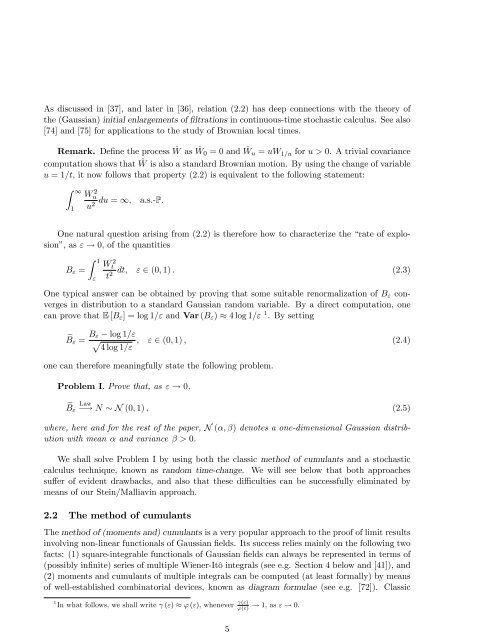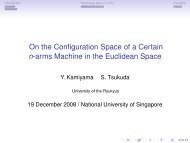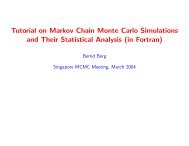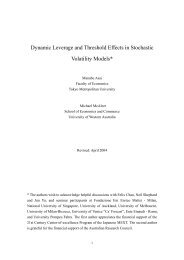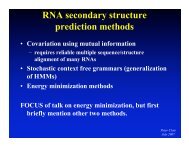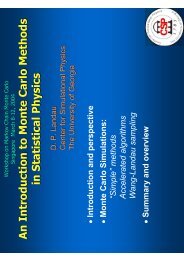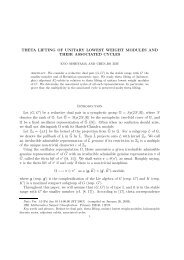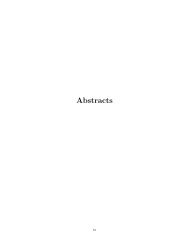Stein's method, Malliavin calculus and infinite-dimensional Gaussian
Stein's method, Malliavin calculus and infinite-dimensional Gaussian
Stein's method, Malliavin calculus and infinite-dimensional Gaussian
You also want an ePaper? Increase the reach of your titles
YUMPU automatically turns print PDFs into web optimized ePapers that Google loves.
As discussed in [37], <strong>and</strong> later in [36], relation (2.2) has deep connections with the theory of<br />
the (<strong>Gaussian</strong>) initial enlargements of …ltrations in continuous-time stochastic <strong>calculus</strong>. See also<br />
[74] <strong>and</strong> [75] for applications to the study of Brownian local times.<br />
Remark. De…ne the process ^W as ^W 0 = 0 <strong>and</strong> ^W u = uW 1=u for u > 0. A trivial covariance<br />
computation shows that ^W is also a st<strong>and</strong>ard Brownian motion. By using the change of variable<br />
u = 1=t, it now follows that property (2.2) is equivalent to the following statement:<br />
Z 1<br />
1<br />
Wu<br />
2 du = 1,<br />
u2 a.s.-P.<br />
One natural question arising from (2.2) is therefore how to characterize the “rate of explosion”,<br />
as " ! 0, of the quantities<br />
B " =<br />
Z 1<br />
"<br />
Wt<br />
2 dt, " 2 (0; 1) . (2.3)<br />
t2 One typical answer can be obtained by proving that some suitable renormalization of B " converges<br />
in distribution to a st<strong>and</strong>ard <strong>Gaussian</strong> r<strong>and</strong>om variable. By a direct computation, one<br />
can prove that E [B " ] = log 1=" <strong>and</strong> Var (B " ) 4 log 1=" 1 . By setting<br />
eB " = B " log 1="<br />
p<br />
4 log 1="<br />
, " 2 (0; 1) ; (2.4)<br />
one can therefore meaningfully state the following problem.<br />
Problem I. Prove that, as " ! 0,<br />
eB "<br />
Law ! N N (0; 1) ; (2.5)<br />
where, here <strong>and</strong> for the rest of the paper, N (; ) denotes a one-<strong>dimensional</strong> <strong>Gaussian</strong> distribution<br />
with mean <strong>and</strong> variance > 0.<br />
We shall solve Problem I by using both the classic <strong>method</strong> of cumulants <strong>and</strong> a stochastic<br />
<strong>calculus</strong> technique, known as r<strong>and</strong>om time-change. We will see below that both approaches<br />
su¤er of evident drawbacks, <strong>and</strong> also that these di¢ culties can be successfully eliminated by<br />
means of our Stein/<strong>Malliavin</strong> approach.<br />
2.2 The <strong>method</strong> of cumulants<br />
The <strong>method</strong> of (moments <strong>and</strong>) cumulants is a very popular approach to the proof of limit results<br />
involving non-linear functionals of <strong>Gaussian</strong> …elds. Its success relies mainly on the following two<br />
facts: (1) square-integrable functionals of <strong>Gaussian</strong> …elds can always be represented in terms of<br />
(possibly in…nite) series of multiple Wiener-Itô integrals (see e.g. Section 4 below <strong>and</strong> [41]), <strong>and</strong><br />
(2) moments <strong>and</strong> cumulants of multiple integrals can be computed (at least formally) by means<br />
of well-established combinatorial devices, known as diagram formulae (see e.g. [72]). Classic<br />
1 In what follows, we shall write (") ' ("), whenever (") ! 1, as " ! 0.<br />
'(")<br />
5


